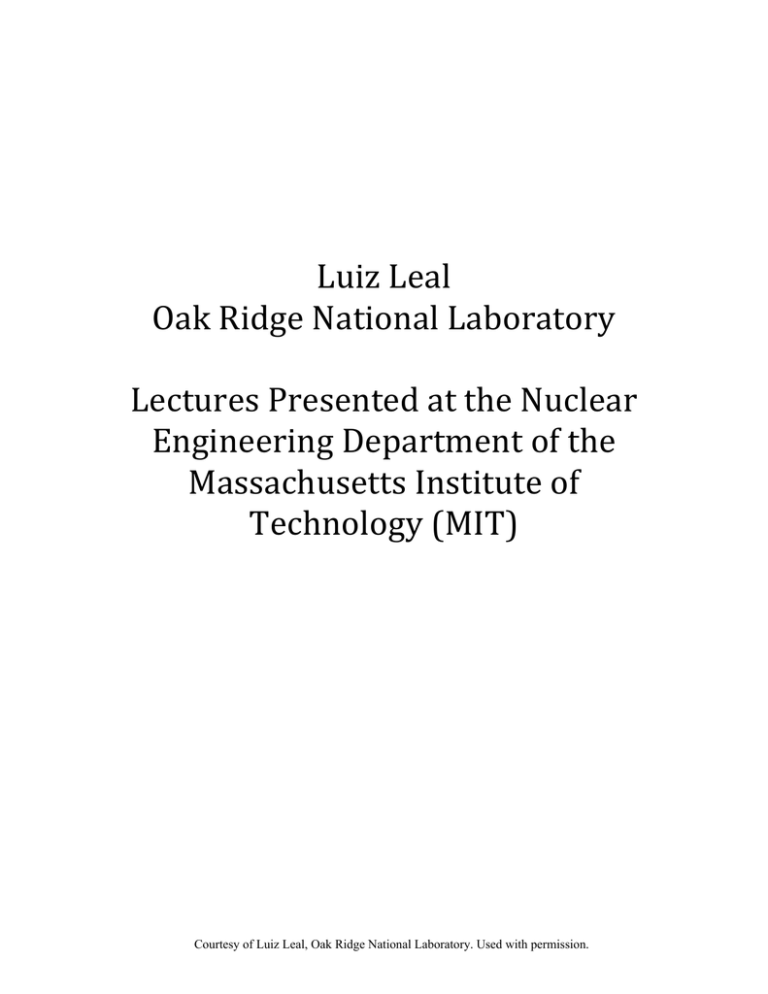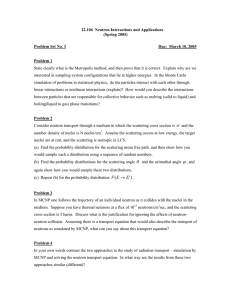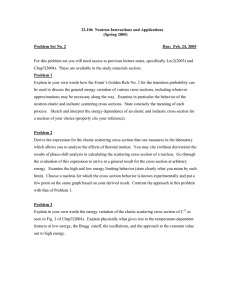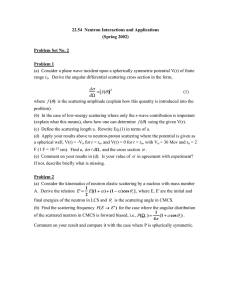Luiz Leal Oak Ridge National Laboratory Le
advertisement

Luiz Leal Oak Ridge National Laboratory Lectures Presented at the Nuclear Engineering Department of the Massachusetts Institute of Technology (MIT) Courtesy of Luiz Leal, Oak Ridge National Laboratory. Used with permission. Neutron Interaction Time Independent Transport Equation for ˆ Φ(E , r ,Ω ) dΩ̂ ' dE' Σ (E'→ E, Ω̂ ' → Ω)Φ(E',r ',Ω̂) + S ∫ ∫ s ∞ Ω̂.∇Φ + Σ t Φ = € € € € 4π 0 Σ t Macroscopic total cross section Σ s Macroscopic scattering cross section How are these quantities treated? (a) Measurement by time‐of‐flight machine, reactors, etc; (b) Evaluated using nuclear physics models; (c) Generated using nuclear physics codes (Poor Choice!) How is nuclear physics applied to get the cross sections? Neutron Interaction n + target → ??? In all three regions there are always: SCATTERING and REACTION Region 1: High energy neutrons – direct and compound nucleus formation; Region 2: Resonance region (resolved and unresolved) – Definitely compound nucleus formation and some direct interactions; Region 3: Chemical region – neutron energy of incident neutron is comparable to the chemical binding energy of atoms in the molecules; The neutron reaction cross sections such as (n, fission), (n, gamma) are affected only by the motion of the target atoms (Doppler broadening effects). In the treatment of the neutron scattering cross section in the chemical region one must consider: (a) Kinetic energy of the incident neutrons is comparable to the binding energy of the atom in the target (molecule, solid, liquid). ATOMS ARE NOT FREE!!! (b) Neutron wavelength is of the order of the interatomic spacing in molecules of crystals; (c) Scattering from various nuclei in the same molecule of crystal interfere (coherent, incoherent); (d) Neutron may GAIN or lose energy; € Born approximation And Fermi pseudo potential Consider the situation: Scattering by a single spinless nucleus ψ (r ) at the detector satisfy the equation: 2 2 − ∇ + V (r ) ψ (r )=Eψ (r ) 2µ € Or [ ∇ + k ] ψ (r )= F(r ) 2 2 Where: 2µE k = 2 2 and 2µ F(r ) = 2 V (r ) ψ (r ) The incident wave describes a free particle traveling in the z direction. It is given as ikz ψ inc (r ) = e € We also know that [∇ + k ] e ikz [∇ + k ] e ikz 2 2 = 0 Suggested homework: Demonstrate that 2 2 = 0 Therefore, the equations to be solved is [ ∇ + k ] ψsc (r )= F(r ) 2 with 2 2µ F(r ) = 2 V (r ) ψ (r ) Recall that ψ (r ) is included in F(r ) € € Green’s Function ψ 0 (r ) Solution at the detector due to a point source at r − r ' € [ ∇ + k ] ψ0 (r )= δ(r −r ') 2 2 ψ 0 (r ) is given as ik|r −r '| e ψ 0 (r ) = − 4 π | r − r '| The solution for ψ sc (r ) is obtained by integrating in volume ik | r −r '| τ € ψ sc (r ) = − ∫ or € τ e F( r ')dτ 4 π | r − r '| € µ ψ sc ( r ) = − 2π 2 ik|r −r '| ∫ τ e V (r ')ψ (r ') dτ 4 π | r − r '| Nice solution of little value since neither V ( r ) nor ψ ( r ) are known quantities. Before proceeding further note that for | r |>>| r '| € 1/ 2 r '.uˆ | r − r '| ≈ r 1− 2 r or | r − r '| ≈ r − r '.uˆ where r uˆ = r Suggested homework: Show that | r − r '| ≈ r − r '.uˆ The function ψ sc (r ) becomes, µ ψ sc ( r ) = − 2 € π 2 −ikr '.uˆ e ikr V (r ')ψ (r ') dτ r −ikr '.uˆ V (r ')ψ (r ') dτ ∫e τ Defining µ f (θ ) = − 2π 2 ∫e τ Hence e ikr ψ sc (r ) = f (θ ) r We know that the differential scattering cross section is given as d 2σ 2 σ (θ ) = = f (θ ) dEdΩ µ σ (θ ) = − 2π 2 ∫e −ikr '.uˆ V ( r ')ψ (r ') dτ τ ψ (r ) The functions and V (r ) are still not Known!!! € € 2 Born Approximation Assumption: The complete wave function ψ (r ) in the potential region is replaced by the incident wave function, that is, ikz € ikr .uˆz ψ (r ) = e = e Rationale: Incident particle is weakly scattered in the potential region, µ σ (θ ) = − 2π 2 ∫e τ −ikr '.(uˆz −uˆ ) V (r ') dτ 2 € € V (r ) is still not known!! Fermi Pseudopotencial Fermi came up with a clever idea for an expression for V ( r ) when the neutron energy is very low. Assumptions: € (a) The potential is applied to s­wave, angular momentum l=0, that is, the potential is spherically symmetric; (b) Short range potential The potential suggested by Fermi is 2π 2 V (r ) = a δ (r ) µ Where a is the scattering length To understand the concept introduced by Fermi let’s continue examining the scattering of neutrons by a single nucleus with no spin effect considered. Recall that: e ikz ψ ( r ) = e + f (θ ) r for r > R ikr 2µE 2 k = Low energy neutron, since 2 , implies € that k → 0 Hence € lim r ψ (r) = r + lim f (θ ) k →0 r> R k →0 r> R The scattering length a is defined as a = − lim f (θ ) k →0 r> R Interpretation of the scattering length a For r=R at the nuclear surface we have € R ψ (R) = R − a or a = R[1− ψ ( R)] (a) ψ (R) = 0 impenetrable sphere and a=R € (b) ψ (R) < 1 a > 0 and a < R € Realistic potential indicating bound states (c) ψ ( R) > 1 a < 0 € No bound states!! The differential scattering cross section with the Fermi pseudopotential is then µ σ (θ ) = − 2π 2 ∫e −ikr .(uˆz −uˆ ) τ 2π a δ (r ) dτ µ for k → 0 (low energy neutrons) € σ (θ ) = a 2 The total scattering cross section is σs = or ∫ σ (θ ) dΩ s 4π σ s = 4π a 2 2 2 The derivation so far assumes that the incident neutrons have very low energy. It is also assumed that the nucleus of mass M is not bound; therefore, the scattering length is called afree. If the neutron interacts with a molecule of mass M’ in which the nucleus of mass M is included, i.e., nucleus bound to the molecule, the Schrödinger equation for the system neutron‐molecule will include the mass between the neutron (m) and the molecule (M’). The scenarios are: (a) System m and M 2 2 − ∇ + V ( r ) ψ ( r )=Eψ (r ) 2µ where µ= mM m+ M € € (b) System m and M’ 2 2 ∇ + V ( r ) ψ ( r )=Eψ (r ) − 2µ' where µ' = mM ' m + M' The Schrödinger equation for the system m and M’ can be written as 2 2 µ' µ' − ∇ ψ (r )+ V (r )ψ (r )= Eψ (r ) µ µ 2µ We see an effective potential for the system m ‐ M ’ a s µ' Veff (r ) = V (r ) µ As we have seen, in the Born approximation together with the Fermi pseudopotential the scattering length with the effective potential is abound or abound µ = 2 2π ∫ Veff (r )dτ τ m+ M µ = 2 M 2π ∫ V (r )dτ τ The relation between abound and afree is abound m+ M = a free M Defining A as the ratio between the nucleus mass M and the neutron mass m, A=M/m we have abound A +1 a free = A Since the low‐energy bound‐scattering cross‐ section is bound 2 bound s σ = 4π a The relation between the bound and unbound scattering cross section is 2 σ bound s A + 1 = σ free A As an example, for A=1 (hydrogen) σ sbound = 4 σ free Suggested homework: (a) Which one is measured σ sfree ? (b) If both, how? € € σ sbound or MIT OpenCourseWare http://ocw.mit.edu 22.106 Neutron Interactions and Applications Spring 2010 For information about citing these materials or our Terms of Use, visit: http://ocw.mit.edu/terms.







